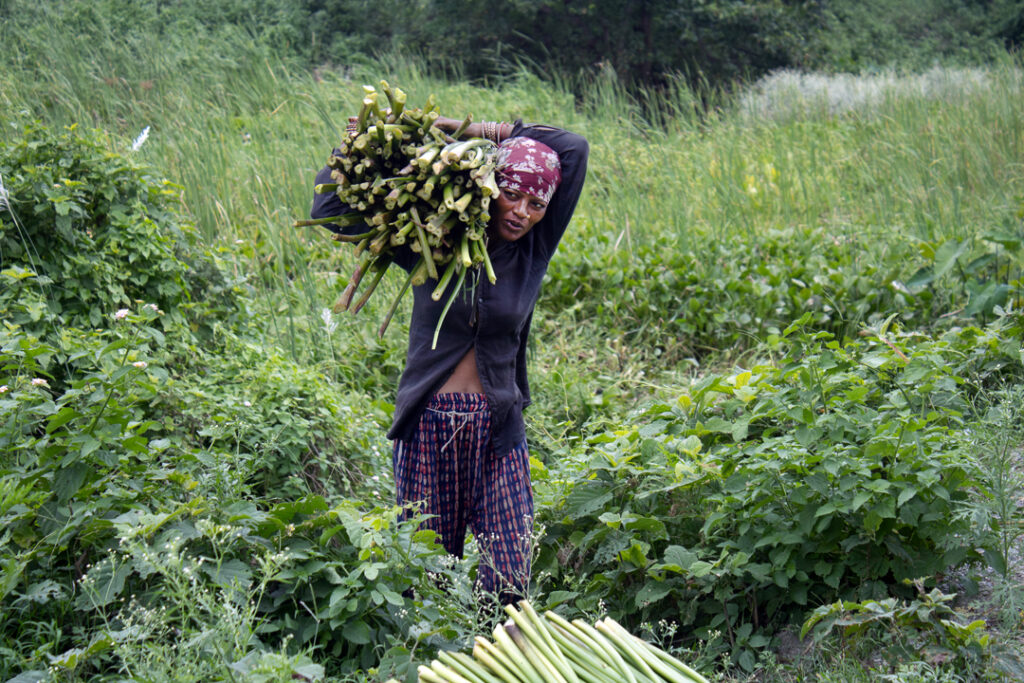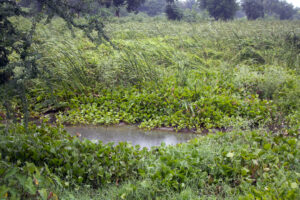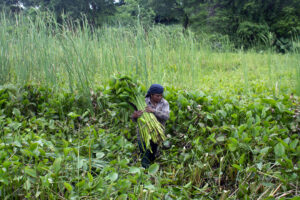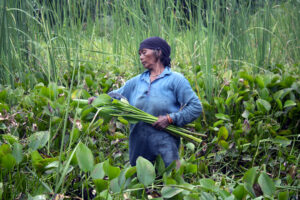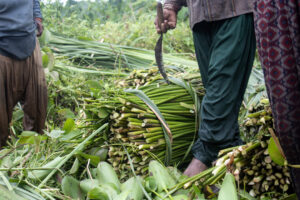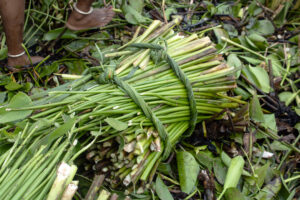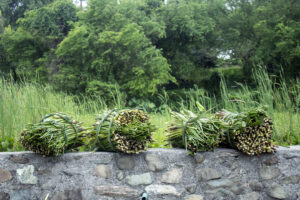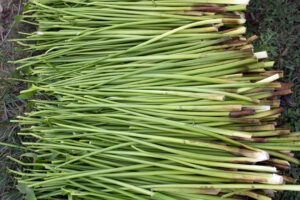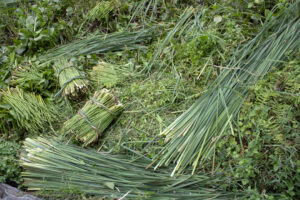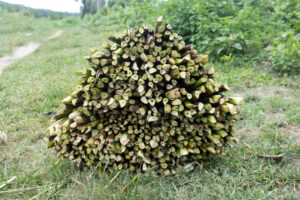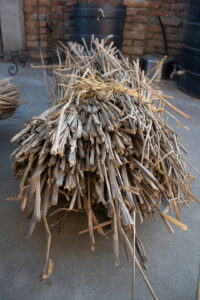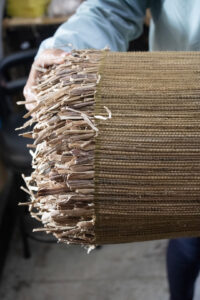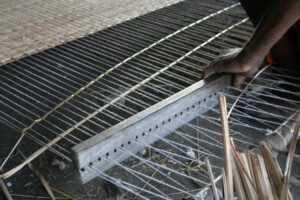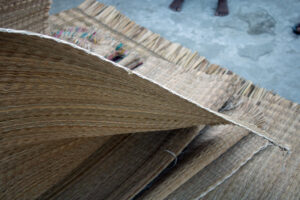Viola Bordon writes about the Sardar community in Nepal which is applying bamboo weaving skills to solve the problem of an invasive species.
In Koshi Tappu, Nepal, the rhythm of life is intertwined with nature. When rain falls, meetings are assumed to be rescheduled, a pleasant discovery for my American sensibilities. Open courtyards blur the lines between indoor and outdoor spaces reflecting the ideological lack of distinction between nature and humanity.
Here, resides the Sardar community who survive through traditions of farming and weaving. For the primarily female practitioners, weaving is not only a supplemental income but also a unifying force. The weaving collective fosters communal bonds, and creates opportunities for creativity and empowerment.
The Sardars practice their craft on common bamboo floor looms, weaving mats to cover their earthen floors and vessels for ceremonies like weddings. Most of what they make stays in the community, although some objects are sold as far as Kathmandu. Through their craftsmanship, they forge a deep connection with the land, utilizing locally sourced cattail with intergenerational skills.
Koshi Tappu is an ecological hotspot, and its wetlands are a habitat for all kinds of creatures. Recently, ecological shifts brought about by the invasive water hyacinth have been threatening it. The floating plant invaded the wildlife reserve, overgrowing and displacing the native cattail. It blocks sunlight and shifts microbiomes, which in turn kill fish and aquatic birds.
Hyacinth has grown along with cattail since its introduction to South Asia during the British Empire. It is an unintended consequence of colonialism in a country that was never colonized. The Sardars have adapted, incorporating water hyacinth into their craft production. Its soft fibers and stem length make it a great material alternative.
As with any adaptation, there are trade-offs. While the use of water hyacinth is a new evolution of traditional craft, it also signals a departure from centuries-old practices. The balance between innovation and tradition is delicate and points to a complex interplay between culture and nature.
- An overgrown pond at Koshi Tappu Wildlife Reserve, 2023, Koshi Tappu Hyacinth Harvest
- Cattail being choked by water hyacinth in Koshi Tappu’s waterway; 2023, Koshi Tappu Hyacinth Harvest
- Mamiya Devi Sardar wades through shallow marsh with fresh fibers; 2023, Koshi Tappu Hyacinth Harvest
- Bhalsar Devi Sardar manuallycuts the leaves off of water hyacinth surrounded by cattail and hyacinth; 2023, Koshi Tappu Hyacinth Harvest
- Harvesting in the Koshi Tappu Wildlife Reserve, 2023, Koshi Tappu Hyacinth Harvest
- Black pigment from the hyacinth root pigments the water, 2023, Koshi Tappu,
- Hyacinth sitting on the wall of the Koshi Tappu Wildlife Reserve; 2023, Koshi Tappu Hyacinth Harvest
- Recently harvested hyacinth; 2023, Koshi Tappu Hyacinth Harvest
- Cattail and hyacinth harvested in tandem; 2023, Koshi Tappu Hyacinth Harvest
- Hyacinth bundle waiting for transport; 2023, Koshi Tappu Hyacinth Harvest
- Hyacinth after sun drying for 7 days; 2023, Koshi Tappu Hyacinth Harvest
- Completed hyacinth mat waiting for finishing; 2023, Koshi Tappu Hyacinth Harvest
- 2023, Koshi Tappu Hyacinth Harvest
- 2023, Koshi Tappu Hyacinth Harvest
- Sanjha Devi Sardar and her husband weaving on a floor loom; 2023, Koshi Tappu Hyacinth Harvest
The Koshi Tappu weavers face additional challenges in the form of conservation and its bureaucratic hurdles. The establishment of the Koshi Tappu Wildlife Reserve in the 1970s on traditional foraging grounds shifted the Sardar community to the Buffer Zone around the reserve. With the further elevation of the site to an internationally protected wetland (Ramsar site) in the 1980s, the Sardar’s access was increasingly restricted. With ecological protections in place, the community’s access to their ancestral lands is now at the discretion of the Community Forrest.
As a governing entity established to foster community access while promoting preservation, Nepals Community Forests is a case study in community-led restoration. The problem is that it adds multiple layers of permissions for an impoverished group to access what has been theirs historically. This fact is compounded when the lack of education, and the illiteracy of this community are taken into account. The recent innovations in weaving are being looked at positively and are prompting discussions within the Wildlife Reserve about community-led harvesting initiatives
I am a material researcher and excited by what the Sardars are doing. Their deep-rooted connection with nature means that the pivot to using what the environment presented was natural. Invasive species used as weaving materials not only present ecological benefits but also challenge the notion of overconsumption in manufacturing cycles.
Using water hyacinth is eco-friendly in its harvesting, processing, manufacturing, and breakdown- something very few contemporary products can claim. This material is a direction toward a sustainable existence, and it is not alone. Across Nepal, innovative material solutions are emerging. Organizations like the Nepal Knotcraft Center are working with indigenous women’s collectives to explore alternative materials and techniques. From pine to nettles, corn to cardamom, artisans are finding new ways to weave from discarded ecological excess.
As they navigate the intricate web of contemporary realities and age-old traditions, the weavers of Koshi Tappu are an example of resilience and innovation. Their craft is a tangible embodiment of a harmonious coexistence of nature with intangible human culture. In many ways, it endures despite the efforts of preservation.
I am inspired by these women.
About Viola Bordon
 Viola Bordon is a Philadelphia-based artist and educator who works with sculpture, drawing, printmaking, and fibers. Bordon’s work with fibers relies on pre-industrial craft histories of weaving and quilting, while her work with landscape suggests questions about sourcing, over-consumption, and human impact on the environment. These interests have led her to her current endeavor, a Fulbright investigating art and craft’s adaptation to the environment through ecological shifts and disasters. She has an MFA in Studio Art and a certification in Emerging Design and Research from the University of Pennsylvania. Viola Bordon is a material researcher with a keen interest in lo-TEK and preindustrial crafts. She is conducting a 10-month Fulbright research grant to Nepal. She has an MFA in studio art with a certification in Emerging Design and Research from the University of Pennsylvania.
Viola Bordon is a Philadelphia-based artist and educator who works with sculpture, drawing, printmaking, and fibers. Bordon’s work with fibers relies on pre-industrial craft histories of weaving and quilting, while her work with landscape suggests questions about sourcing, over-consumption, and human impact on the environment. These interests have led her to her current endeavor, a Fulbright investigating art and craft’s adaptation to the environment through ecological shifts and disasters. She has an MFA in Studio Art and a certification in Emerging Design and Research from the University of Pennsylvania. Viola Bordon is a material researcher with a keen interest in lo-TEK and preindustrial crafts. She is conducting a 10-month Fulbright research grant to Nepal. She has an MFA in studio art with a certification in Emerging Design and Research from the University of Pennsylvania.
All the photographs were taken by Viola Bordon.

